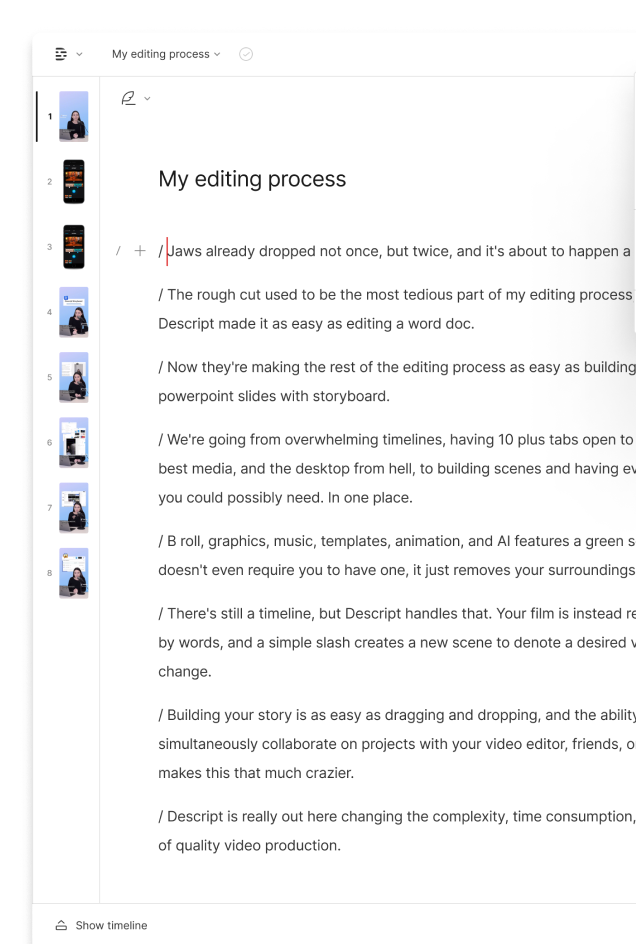What type of content do you primarily create?




If you're a content creator looking to connect to your audience, learning how to maintain eye contact is one of the lowest-effort ways to do that. Eye contact is important to human beings on an evolutionary level: it helps us show we’re interested and paying attention. It’s also a quick and easy way to build connection and trust with whoever you’re talking to. Plus, it’s an instant display of confidence.
But as a creator, rather than locking eyes with another person, you’re expected to look directly into the camera as if it's a person, all while delivering lines you may or may not have memorized. Don’t let that dishearten you. These days, there are a variety of new ways to get your eyes locked to the lens.
1. Look directly into the camera
Sometimes the tried-and-true method is the easiest. If you’re off-book or okay improvising, there’s nothing wrong with saying your lines and looking directly into the lens.
Pros:
- It looks the most natural
- No extra cost
Cons:
- Requires memorizing your script
- More mistakes, leading to more editing
2. Use a teleprompter
Calm down there, Lester Holt. Purchasing a real teleprompter is an investment, and it's not always worth the cost. If you film with a smartphone or prefer improvising your lines, definitely skip this one.
 |
Teleprompters are made up of a horizontal screen displaying your script and a piece of transparent glass mounted in front of the camera lens at a 45 degree angle that reflects the script on the display so you can read it. They’re most commonly used in broadcast television news and talk show studios, though there are more lightweight versions out there designed for digital content creators.
On the fence? Read more in our article, How do teleprompters work, and do I need one?
Pros:
- Maintain eye contact without memorizing a script
- Adds a level of professionalism to your shoots
Cons:
- Additional cost that requires additional setup
- Still shows some eye movement
- Requires additional software
3. Use virtual teleprompter software
Rather than shell out a few hundred dollars for a physical teleprompter, try looking into an app that can help you achieve the same outcome. There are a variety of mobile and desktop apps that scroll through your script. You can’t get the same precision of looking into the camera as a real teleprompter, but you can get close.
Want to go this route? You’re in luck; we wrote an entire article on the Top 8 best teleprompter software picks for professional video. One of those picks? Descript, of course. While it's not technically teleprompter software, it acts just like it: All you have to do is write your script in-app and read from it while using Descript to record your video.
 |
Pros:
- Cheaper than a real teleprompter
- No bulky equipment
- No memorization necessary
Cons:
- You can’t look directly at the camera as you read
4. Fix eye contact later with AI
We saved the best for last.
Meet our modern solution for the age-old problem of eye contact. With the click of a button, Descript’s AI can make your eyeballs look directly into the camera, even if you were looking down at your script, over at your pet, or off into the endless void.
Learn more about Descript’s AI-powered Eye Contact correction.
Pros:
- Don’t have to memorize your script
- Cuts down on retakes and saves time in the edit
- No additional software or gear required
Cons:
- Can occasionally glitch if you’re looking too far off-camera
FAQ
How do you edit eye contact in a video?
If you want to edit your eye contact in a video, the fastest and easiest way to do so is using Descript’s AI Eye Contact feature. It uses AI to subtly adjust your gaze in video so it appears you're looking directly into the camera—even when you’re reading something off-camera. All you have to do is click a button and turn it on.
How do you keep eye contact in a video call?
To maintain eye contact during a video call, focus on looking directly into the camera. This may feel awkward at first, but it creates the impression that you're making eye contact with the other participants.
How do you make eye contact in a video?
There are a variety of ways you can maintain eye contact while filming a video:
- Memorize your script and look directly into the camera
- Use a physical teleprompter or a teleprompter app
Use AI, like Descript's Eye Contact feature, to correct your gaze later.



































